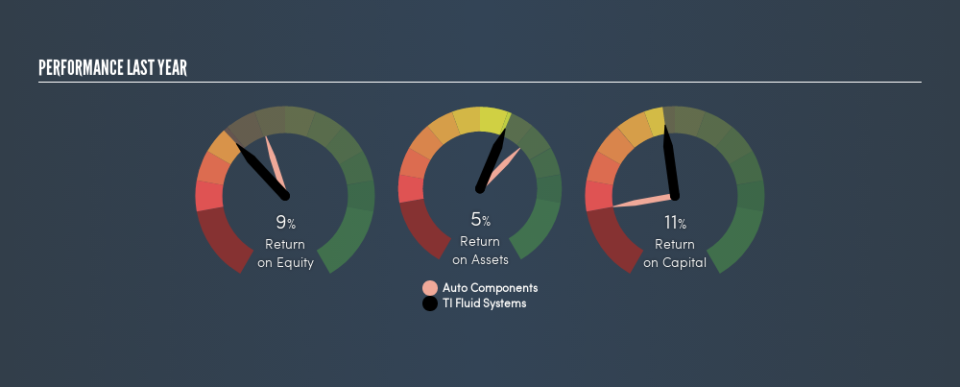Don’t Buy TI Fluid Systems plc (LON:TIFS) Until You Understand Its ROCE

Today we’ll look at TI Fluid Systems plc (LON:TIFS) and reflect on its potential as an investment. Specifically, we’ll consider its Return On Capital Employed (ROCE), since that will give us an insight into how efficiently the business can generate profits from the capital it requires.
First of all, we’ll work out how to calculate ROCE. Then we’ll compare its ROCE to similar companies. Then we’ll determine how its current liabilities are affecting its ROCE.
Understanding Return On Capital Employed (ROCE)
ROCE is a measure of a company’s yearly pre-tax profit (its return), relative to the capital employed in the business. Generally speaking a higher ROCE is better. In brief, it is a useful tool, but it is not without drawbacks. Author Edwin Whiting says to be careful when comparing the ROCE of different businesses, since ‘No two businesses are exactly alike.’
So, How Do We Calculate ROCE?
Analysts use this formula to calculate return on capital employed:
Return on Capital Employed = Earnings Before Interest and Tax (EBIT) ÷ (Total Assets – Current Liabilities)
Or for TI Fluid Systems:
0.11 = €283m ÷ (€3.3b – €721m) (Based on the trailing twelve months to June 2018.)
Therefore, TI Fluid Systems has an ROCE of 11%.
Check out our latest analysis for TI Fluid Systems
Does TI Fluid Systems Have A Good ROCE?
When making comparisons between similar businesses, investors may find ROCE useful. We can see TI Fluid Systems’s ROCE is around the 11% average reported by the Auto Components industry. Independently of how TI Fluid Systems compares to its industry, its ROCE in absolute terms appears decent, and the company may be worthy of closer investigation.
Remember that this metric is backwards looking – it shows what has happened in the past, and does not accurately predict the future. ROCE can be deceptive for cyclical businesses, as returns can look incredible in boom times, and terribly low in downturns. ROCE is only a point-in-time measure. Future performance is what matters, and you can see analyst predictions in our free report on analyst forecasts for the company.
TI Fluid Systems’s Current Liabilities And Their Impact On Its ROCE
Liabilities, such as supplier bills and bank overdrafts, are referred to as current liabilities if they need to be paid within 12 months. Due to the way ROCE is calculated, a high level of current liabilities makes a company look as though it has less capital employed, and thus can (sometimes unfairly) boost the ROCE. To counteract this, we check if a company has high current liabilities, relative to its total assets.
TI Fluid Systems has total assets of €3.3b and current liabilities of €721m. Therefore its current liabilities are equivalent to approximately 22% of its total assets. Current liabilities are minimal, limiting the impact on ROCE.
Our Take On TI Fluid Systems’s ROCE
This is good to see, and with a sound ROCE, TI Fluid Systems could be worth a closer look. Of course you might be able to find a better stock than TI Fluid Systems. So you may wish to see this free collection of other companies that have grown earnings strongly.
I will like TI Fluid Systems better if I see some big insider buys. While we wait, check out this free list of growing companies with considerable, recent, insider buying.
We aim to bring you long-term focused research analysis driven by fundamental data. Note that our analysis may not factor in the latest price-sensitive company announcements or qualitative material.
If you spot an error that warrants correction, please contact the editor at editorial-team@simplywallst.com. This article by Simply Wall St is general in nature. It does not constitute a recommendation to buy or sell any stock, and does not take account of your objectives, or your financial situation. Simply Wall St has no position in the stocks mentioned. Thank you for reading.

